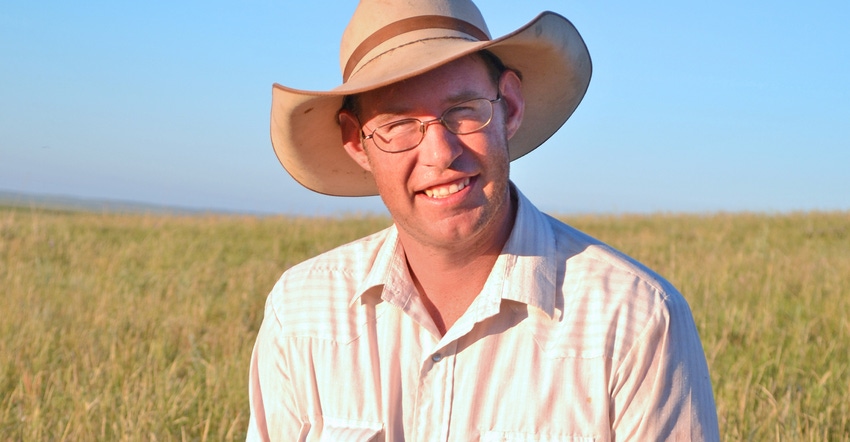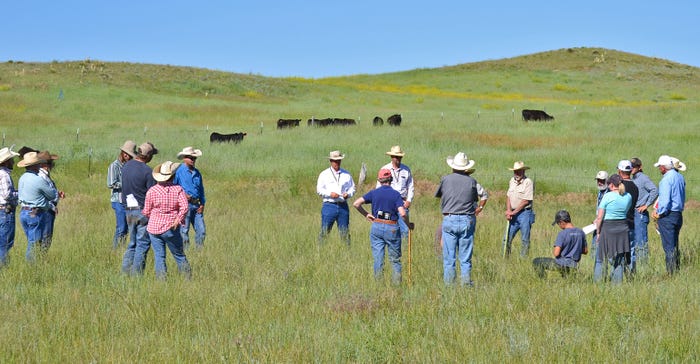September 26, 2019

When it comes to forage management, ranchers are finding that high-density, short-duration grazing combined with ample recovery time can boost forage resources. In fact, for Sage and Faith Askin, Wyoming livestock producers who run rangelands and pastures they lease, the practice has meant a dramatic boost to forage resources.
“The power of density is the craziest thing,” Sage Askin says. “We have sites where we’ve bedded 1,500 ewes weighing 120 pounds in a half-acre or less. We continue to use bigger and bigger herds of cattle to get the density up, including up to 1,340 yearlings in grazing paddocks as small as 35 acres.”
Livestock are moved regularly to ensure plenty of forage is left behind, and that grasses and forbs can fully recover before being grazed again.
Among the many benefits, Askin says, is the fact that manure and urine are distributed across the entire pasture, and the manure is quickly broken down by constant hoof activity — meaning nutrients are getting into the soil vs. cow patties drying out and staying on top of the surface. This free fertilizer is among the many reasons why the Askins are seeing a boost in forage.
“These sites have more organic matter in the soil, and they are developing more plants that are lush, green and higher in energy,” Askin claims. “Stock density is a very powerful tool that can multiply the effect of each of the other grazing tools. If we change up the timing of use, it’s a good thing. If we do it with added density, it compounds any changes faster.”
A plan for grazing management
Tom Ford, who works on a 73,000-acre Wyoming ranch that is taking many steps to improve grazing management, says he and brothers Kellen and Cameron Smith — who co-manage the ranch — are looking at everything big and small to bolster forage resources.
For example, Ford says, one 100-acre dryland pasture was hayed for many years. Starting in 2017, they began intensively grazing the pasture for a short period, leaving at least 30% standing residual behind.
Urine and manure were evenly distributed across the pasture, and the high number of animals trampled the manure, Ford says. He adds that the standing residual is catching more moisture than when the pasture was hayed.
“There are now more nutrients and water going into the soil; and in only three years, we are definitely seeing an increase in forage on that 100 acres,” he says. “It was previously worth haying that pasture in most years, but we’re seeing even bigger financial benefits now.”

FIELD SCHOOL: Ranchers got a solid education in managing rangelands and pastures at one of Jim Gerrish’s Management-intensive Grazing schools recently. Gerrish and his co-instructors teach a class on estimating the amount of forage that is in a grazing paddock, and then how to use that information to determine the forage use target combined with the grazing period.

Ford, the Smith brothers and the Askins all believe in continuing education. They all talked about how the Ranching for Profit School, led by Dave Pratt and others, and the Management-intensive Grazing School, led by Jim Gerrish, help them to become more profitable and sustainable.
“If things are working for someone else, you don’t have to reinvent the wheel,” Kellen Smith says. “I was kind of getting stuck in the past, but I am learning that if you open your eyes and mind, there are better and more effective ways to make a profit.”
Cameron Smith adds: “Schools like Ranching for Profit and MiG are completely opening our eyes to different thought processes, different ways to do it better.”
During the four-day MiG school in Wyoming last year, Gerrish continually questioned the students and challenged them to think outside of the box — whether it had to do with big things like stock density and the time and timing of grazing, or small things like effectively managing manure and urine to build profits the inexpensive way.
“When was the last time you thought about what comes out of the back end of your animals?” Gerrish asked. “How is that manure distributed? Are those piles just sitting on the ground not doing anything because of low stocking rates, or are the piles being quickly broken down, with the nutrients cycling back into the soil? Answers to questions like that are driven directly by your day-to-day management decisions.”
Put more energy into your soil
Grazing expert Gerrish urges ranchers to focus more energy on learning about soil and how to improve it through carefully managed grazing.
Among the many ways to improve the soil is to keep the ground covered with actively growing plants during spring, summer and fall, and ample residue during winter. For example, when the ground is covered in the heat of summer, the soil remains cooler, resulting in less evaporative water loss and a moderation of many biological processes.
“The loss of nitrogen from the soil accelerates as soil temperatures rise, and N fixation by legumes decreases,” he says. “When soil temperatures get above about 80 degrees [F], a lot of less desirable biological processes accelerate, while desirable processes slow.”
Gerrish adds that the ability of soil to recover from drought, floods and many other weather-related events improves if there is more living material on the surface during the growing season. This means managing grazing carefully to ensure a healthy mix of cool- and warm-season grasses along with legumes. It’s also important to move livestock while plenty of vegetation remains, and give pastures adequate time to recover.
Additional reading
Among the resources focusing on soil management and other aspects important to boosting forage resources on rangelands and pastures are the following four books:
• “Dirt to Soil: One Family’s Journey into Regenerative Agriculture,” by Gabe Brown
• “The Drought Resilient Farm,” by Dale Strickler
• “Management-intensive Grazing, The Grassroots of Grass Farming,” by Jim Gerrish
• Kick the Hay Habit: A Practical Guide to Year-Round Grazing,” by Gerrish
All these titles can be found at amazon.com.
Waggener writes from Laramie, Wyo.
About the Author(s)
You May Also Like




